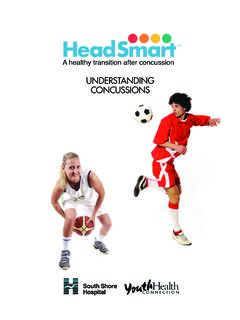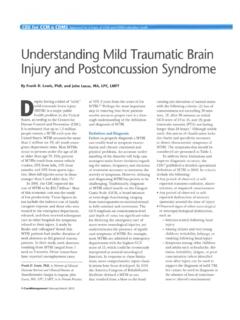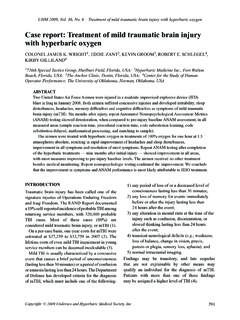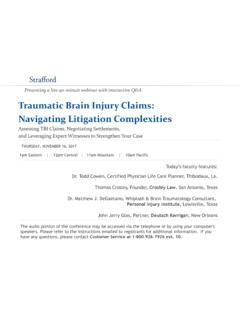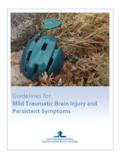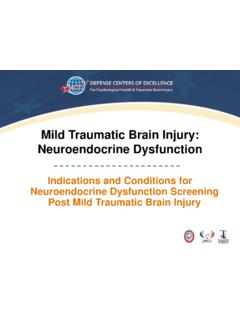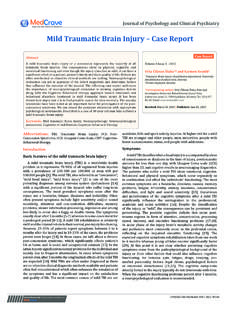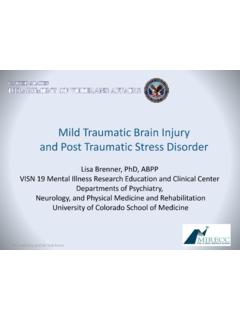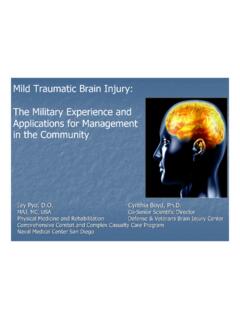Transcription of Heads Up - Sports Concussion Institute
1 Facts for Physicians Heads Up Facts for Physicians About mild traumatic brain injury (MTBI). Department of Health and Human Services Centers for Disease Control and Prevention FACTS. Physicians can play a key role in helping to prevent mild traumatic brain injury (MTBI or Concussion ) and in appropriately identifying, diagnosing, and manag . ing it when it does occur. Physicians can also improve patient outcomes when MTBI is suspected or diagnosed by implementing early management and appropriate referral. MTBI symptoms may appear mild , but can lead to signifi . cant, life-long impairment affecting an individual's ability to function physically, cognitively, and psychologically. Appropriate diagnosis, referral, and patient and family/caregiver education are critical for helping patients with MTBI. achieve optimal recovery and to reduce or avoid significant sequelae. This tool kit was developed to provide physicians with a more individualized assessment of MTBI and to help guide the management and recovery of patients with MTBI.
2 Definition of mild traumatic brain injury (MTBI). The term mild traumatic brain injury (MTBI) is used interchangeably with the term Concussion . An MTBI or Concussion is defined as a complex patho . physiologic process affecting the brain , induced by traumatic biomechani . cal forces secondary to direct or indirect forces to the head. MTBI is caused by a blow or jolt to the head that disrupts the function of the brain . This disturbance of brain function is typically associated with normal structural neuroimaging findings ( , CT scan, MRI). MTBI results in a constellation of physical, cognitive, emotional and/or sleep-related This tool kit includes: symptoms and may or may not involve A patient assessment tool, a loss of consciousness (LOC). Duration titled Acute Concussion of symptoms is highly variable and may Evaluation; . last from several minutes to days, weeks, An information sheet for months, or even longer in some ,2 patients who recently sustained a Concussion , titled Magnitude of MTBI Acute Concussion Evaluation Care Plan.
3 A palm card with information An estimated 75%-90% of the mil . lion traumatic brain injury (TBI)-related about the on-field deaths, hospitalizations, and emergency management of Concussion , department visits that occur each year are titled Concussion in Sports ; . concussions or other forms of MTBI. 3-6 A general fact sheet for patients, titled, Heads Up: Approximately million Sports - Preventing Concussion ; and and recreation-related TBIs occur in the A CD-ROM with downloadable United States each Most of these tool kit materials and are MTBIs that are not treated in a hospi . additional resources. tal or emergency department.. FACTS. Blasts are an important cause of MTBI among military personnel in war Direct medical costs and indirect costs such as lost productivity from MTBI totaled an estimated $12 billion in the United States in Individuals with a history of Concussion are at an increased risk of sustain.
4 Ing a subsequent Duration of symptoms is highly variable and may last from several min . utes to days, weeks, months, or even longer in some cases. Research shows that recovery time may be longer for children and ,12. Symptoms or deficits that continue beyond three months may be a sign of post- Concussion (See page 4 for a list of common signs and symptoms of MTBI.). With proper diagnosis and management, most patients with MTBI re . cover ,15. Leading causes of MTBI (seen in emergency departments)16 Groups at highest risk for MTBI16. Falls; Infants and children (ages 0 to 4);. Motor vehicle trauma; Children and young adults (ages 5. Unintentionally struck by/against to 24); and events; Older adults (ages 75 or older). Assaults; and Sports . Neuropathophysiology of MTBI. Unlike more severe TBIs, the disturbance of brain function from MTBI is related more to dysfunction of brain metabolism rather than to structural injury or damage.
5 The current understanding of the underlying pathology of MTBI involves a paradigm shift away from a focus on anatomic damage to an emphasis on neuronal dysfunction involving a complex cascade of ionic, metabolic and The CD-ROM included in physiologic events. Clinical signs and symp . this tool kit contains more toms of MTBI such as poor memory, speed of information about the processing, fatigue, and dizziness result from neuropathophysiology of this underlying neurometabolic MTBI, downloadable kit materials, and additional MTBI-related research articles and resources.. DIAGNOSIS. Signs and Symptoms Signs and symptoms of MTBI generally fall into four categories: physical, cognitive, emotional, and sleep, and may include: Physical Cognitive Emotional Sleep Headache Feeling mentally Irritability Drowsiness Nausea foggy Sadness Sleeping less Vomiting Feeling slowed More emotional than usual Balance down Nervousness Sleeping more problems Difficulty than usual Dizziness concentrating Trouble falling Visual problems Difficulty asleep Fatigue remembering Sensitivity to Forgetful of light recent Sensitivity to information or noise conversations Numbness/ Confused about Tingling recent events Dazed or Answers stunned questions slowly Repeats questions Diagnosis Diagnosing MTBIs can be challenging MTBI is an important concern among as symptoms of MTBI are common military personnel returning from war to those of other medical conditions zones.
6 Symptoms of MTBI may be (such as post- traumatic stress disorder missed or may not be noticed until [PTSD], depression, and headache syn . after they have returned home. The dromes), and the onset and/or recog . nition of symptoms may occur days or identification and management of weeks after the initial ,18 MTBI in these patients may also be A systematic assessment of the injury complicated by the presence of PTSD. and its manifestations is essential to proper management and reduced mor For more information about TBI in bidity. The Acute Concussion Evalua returning military personnel, please tion (ACE) form included in this tool see the paper titled, mild traumatic kit was developed to provide physi brain injury : Military Considerations, . cians with an evidence-based protocol included on the CD-ROM and/or visit to conduct an initial evaluation and di the Defense and Veterans brain injury agnosis of patients (both children and Center's Website at.)
7 Adults) with known or suspected MTBI. The research evidence documenting the importance of these components in the evaluation of an MTBI is pro . vided in the reference list (see page 23). The ACE can also be used serially to track symptom recovery over time. It provides a systematic protocol for assessing the key components for diagnosing an MTBI and serves as the basis for management and referral recommendations provided by the ACE Care Plan (two versions). These tools were developed to provide physicians with a more individualized assessment of MTBI and to help guide the management DIAGNOSIS. and recovery, as well as the referral of patients with such injuries. The ACE contains three major components that require evaluation: Characteristics of the injury ;. Types and severity of the symptoms; and Risk factors that can lead to a protracted period of recovery. The ACE should be administered to patients for whom Concussion is clearly indicated ( , loss of con.
8 Sciousness or change in mental status, confusion or amnesia) and to those for whom Concussion should be suspected ( , other traumatic injuries are observed or reported; forcible blow to the head with functional changes). For example, concussions are often not recognized among children with orthopedic injuries. Physicians should consider screening for possible Concussion among patients with various other types of injuries such as: High-speed activities (motor vehicle crashes, bicycle riding, skateboarding). Sports and recreation activities Falls (including those among older adults), especially from a significant distance ( , off a ladder, from a tree). Suspected child maltreatment ( , shaking, hitting, throwing). Exposure to blasts (includes military personnel returning from war zones). Injuries to the external parts of the head and/or scalp ( , lacerations). The following summarizes the information contained on the ACE and outlines steps for diagnosing a patient with a known or suspected MTBI.
9 Detailed instructions about how to use the ACE are provided on the back page of the form.. A. injury Characteristics 1. injury Description. Ask the patient (and/or parent, if child) about how the injury occurred, type of force, and location on the head or body where the force (blow) was received. Different biomechanics of injury may result in varied symptom patterns. For example, an injury that occurs to the posterior aspect of the head may result in visual changes, balance problems, and fatigue. The force to the head may be indirect, such as with an individual being struck in the DIAGNOSIS. body resulting in the head accelerating forward and then backward quickly ( , whiplash). 2. Cause. The cause of the injury may also help to estimate the force of the hit or blow the patient sustained. The greater the force associated with the injury , the more likely the patient will present with more severe symptoms. Conversely, significant symptoms associated with a relatively light force might indicate an increased vulnerability to MTBI.
10 (especially among patients with a history of multiple MTBIs or pre . existing history of migraine) or the presence of other physical or psychological factors contributing to symptom exacerbation. 3. Amnesia (Retrograde). Determine whether amnesia (memory loss). has occurred for events before the injury and attempt to determine the length of time of memory dysfunction. Research indicates that even seconds of amnesia may predict more serious 4. Amnesia (Anterograde). Determine whether amnesia has occurred for events after the injury and attempt to determine the length of time of memory dysfunction. Anterograde amnesia is also referred to as post- traumatic amnesia (PTA). 5. Loss of Consciousness (LOC). Inquire whether LOC occurred or was observed and the length of time the patient lost consciousness. (Note: Research indicates that up to 90% of concussions do not involve LOC.)19,20. 6. Early Signs Observed by Others.
